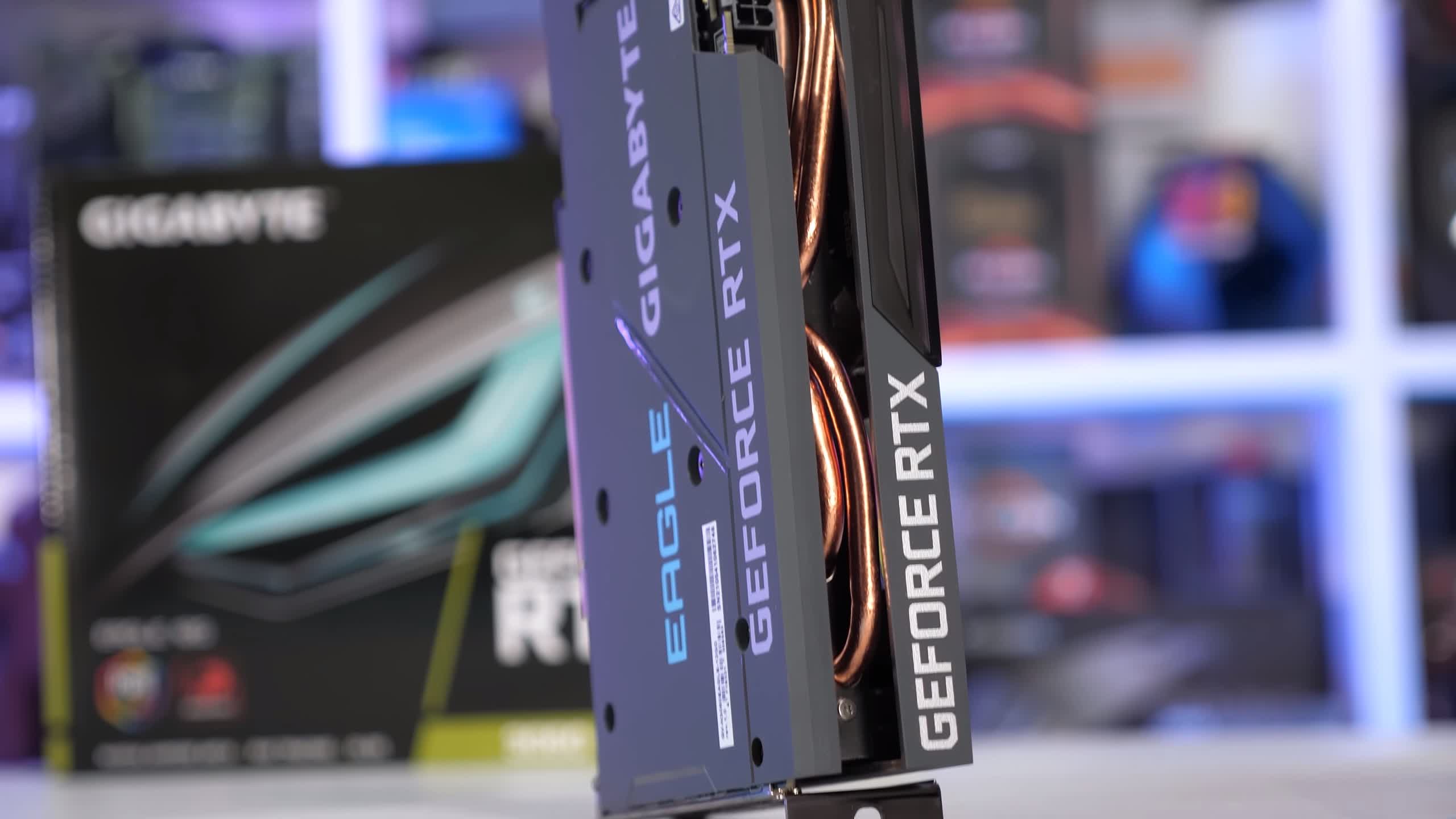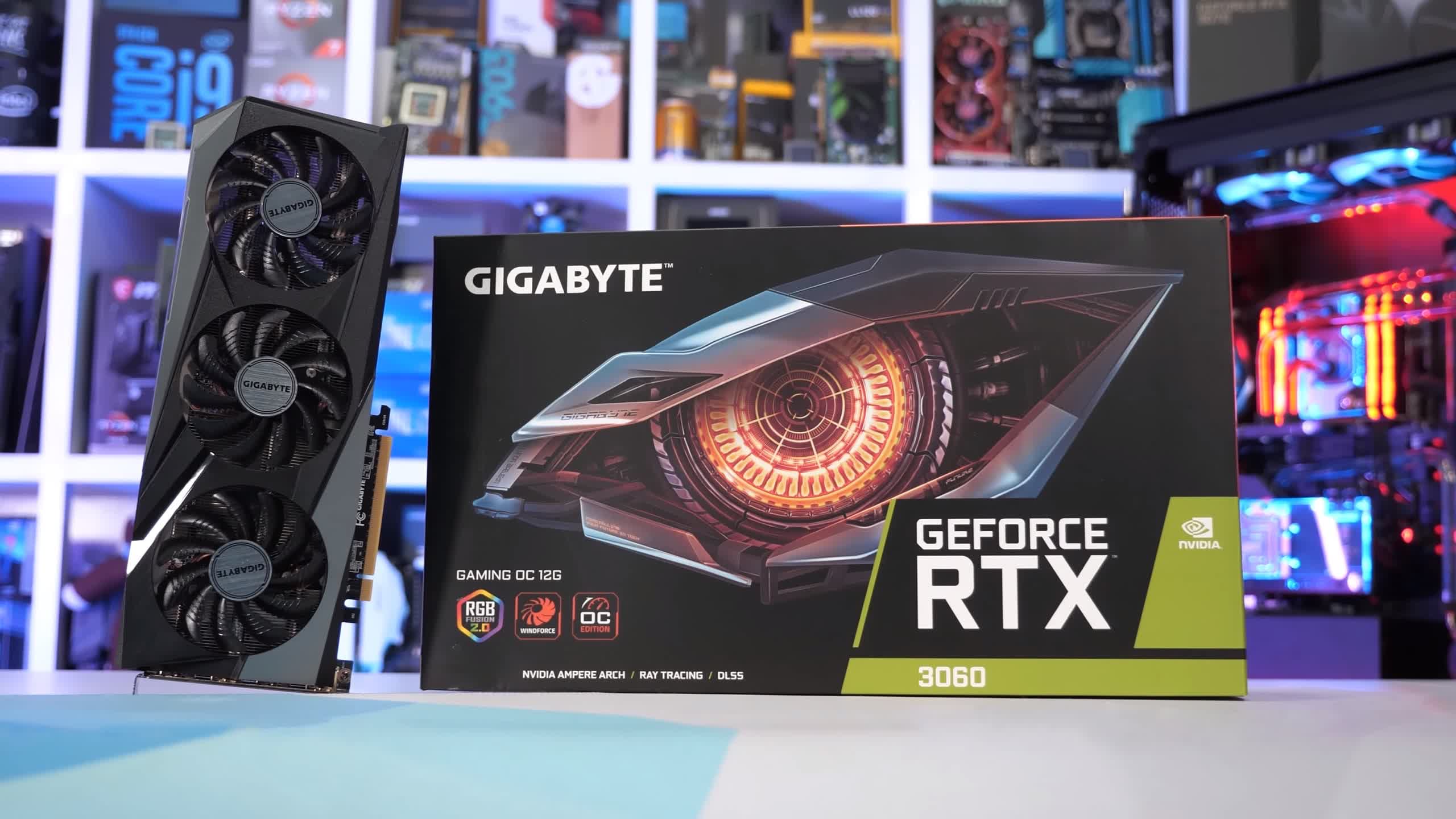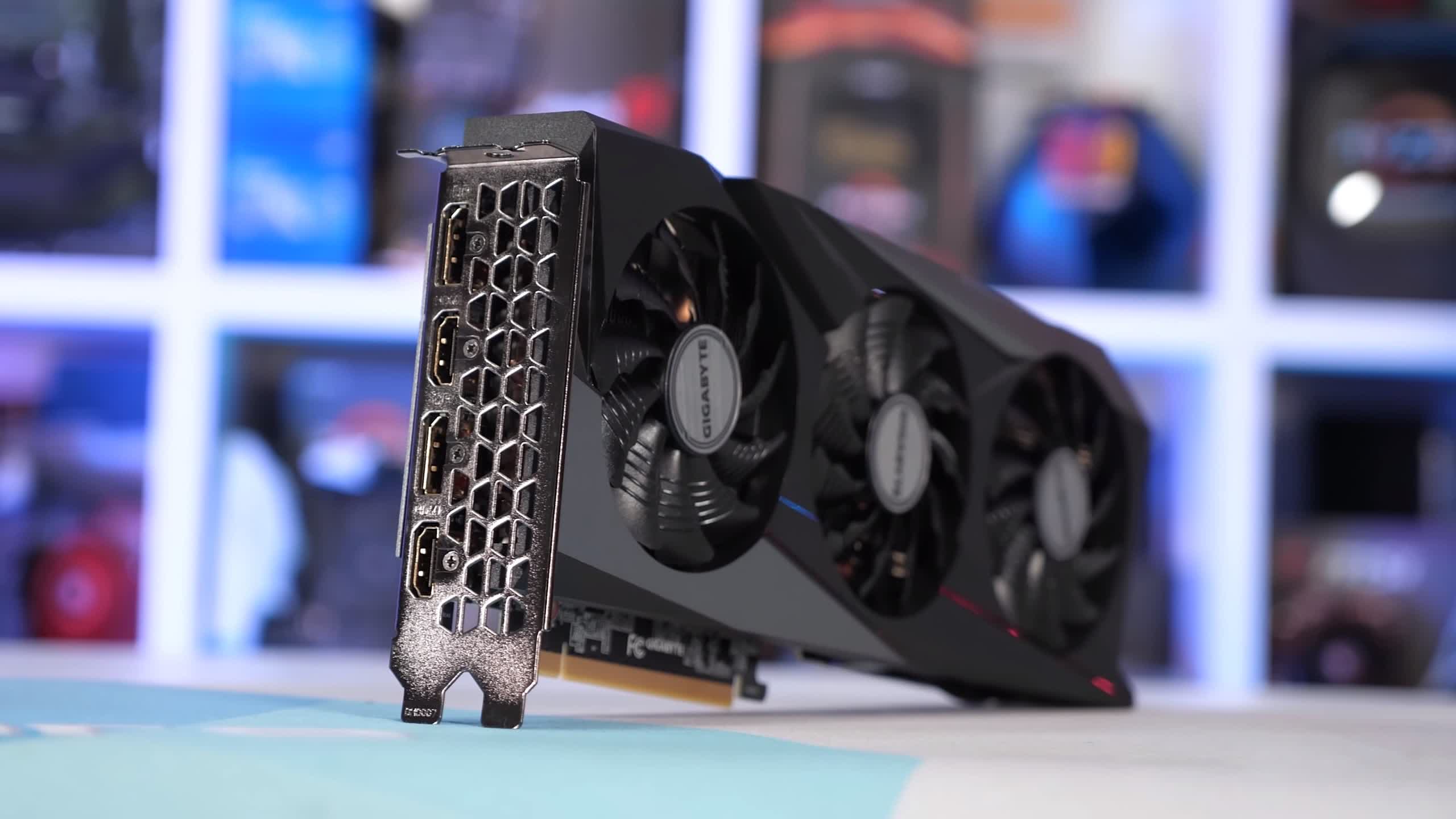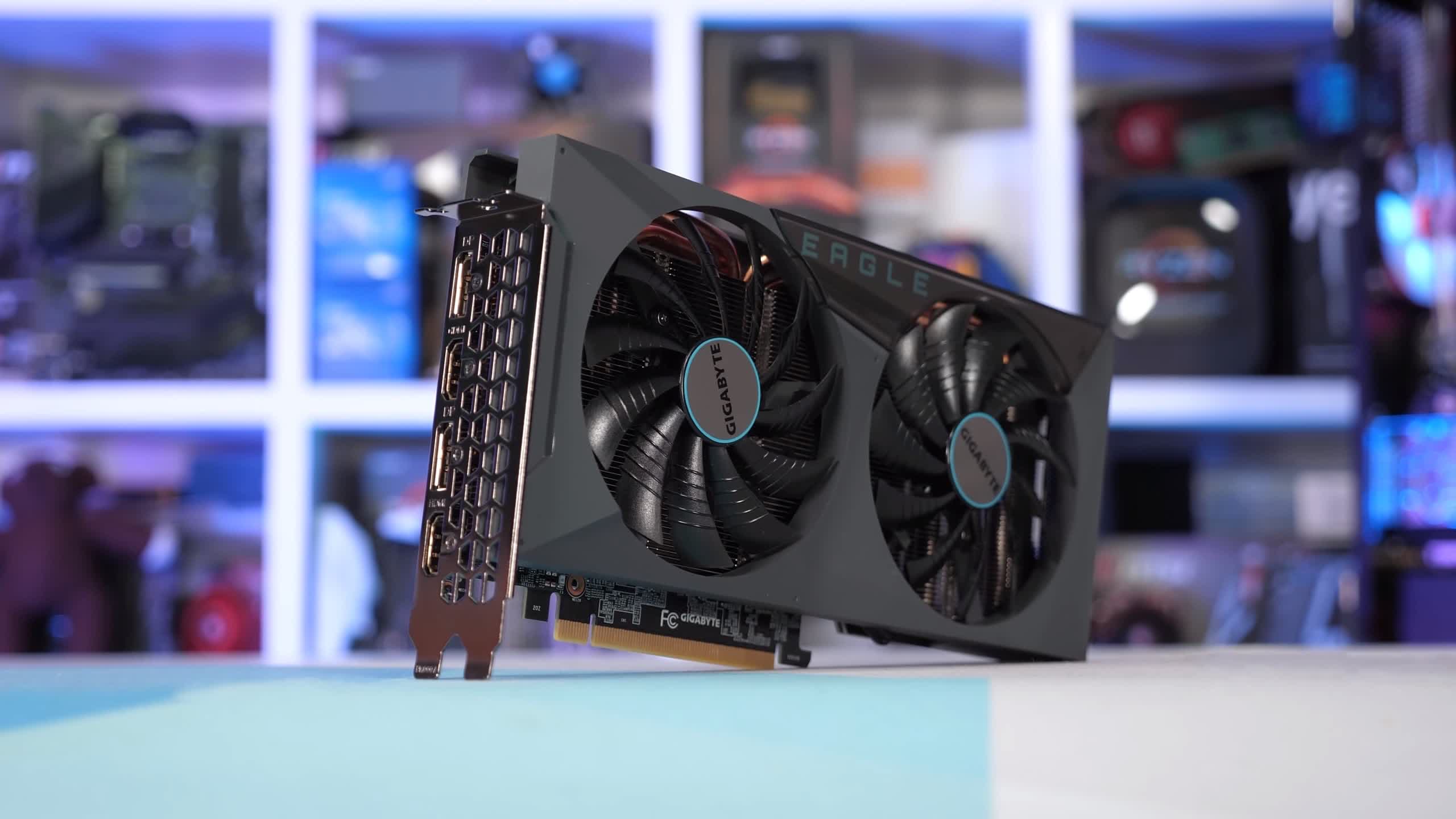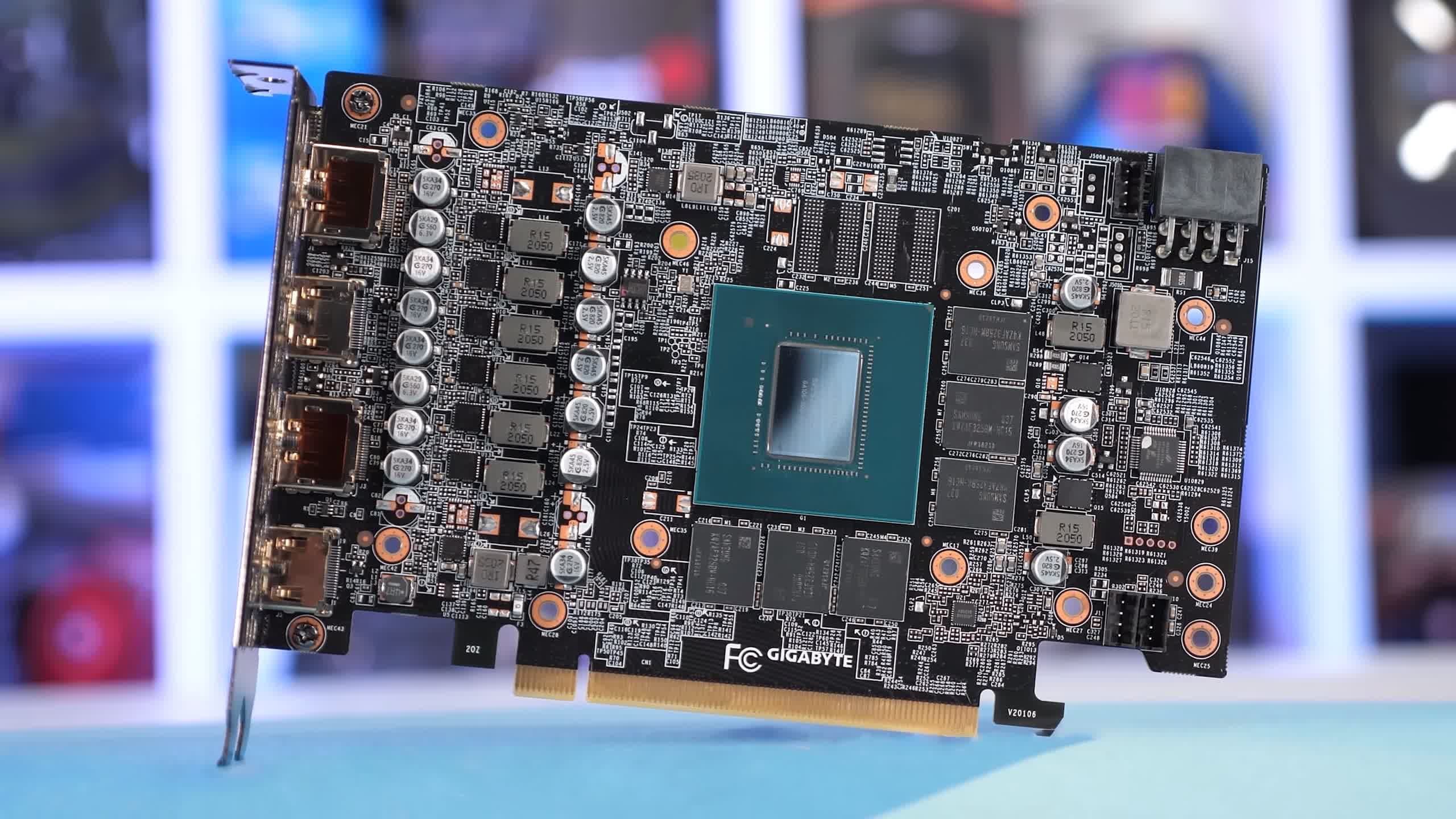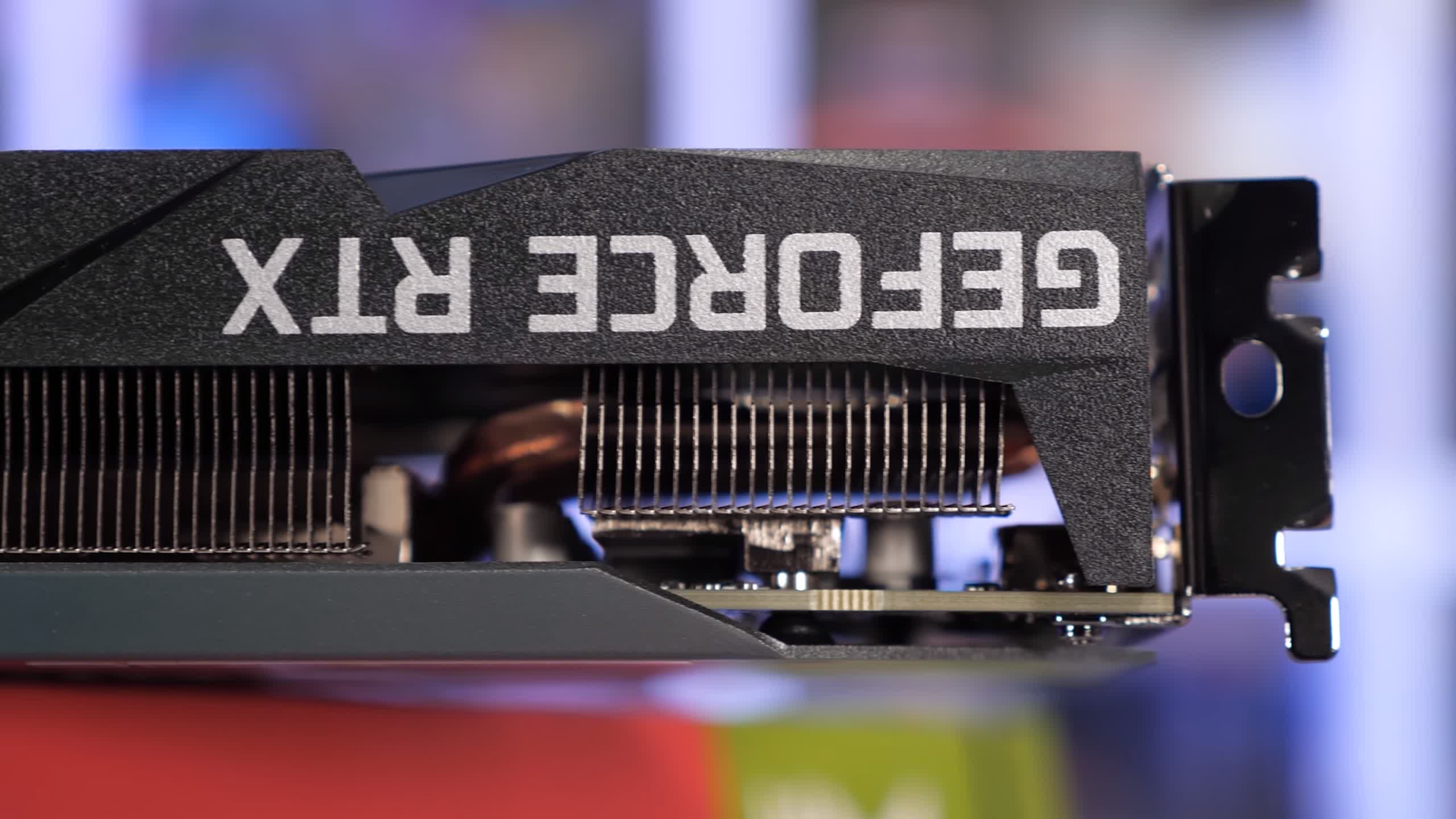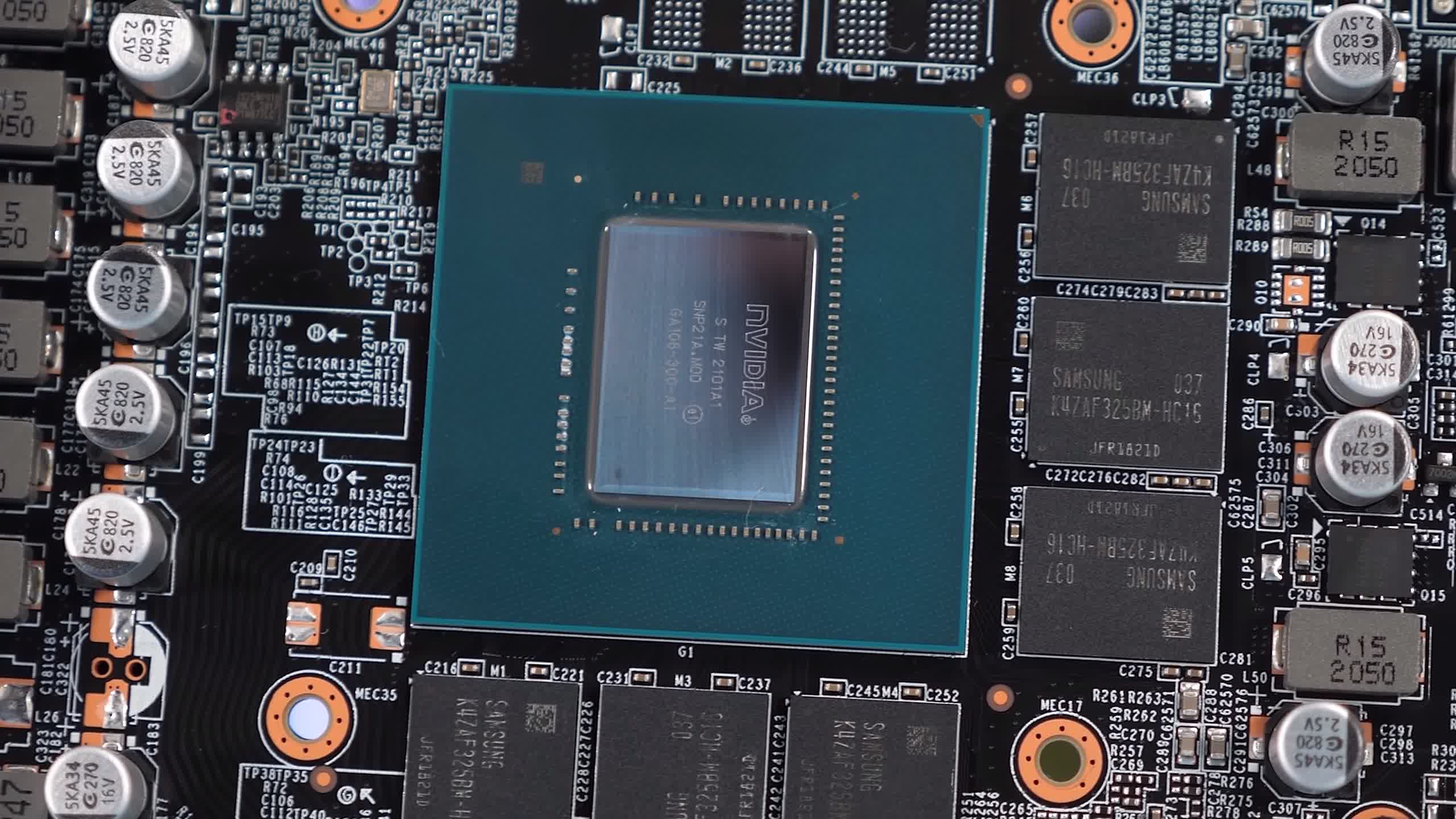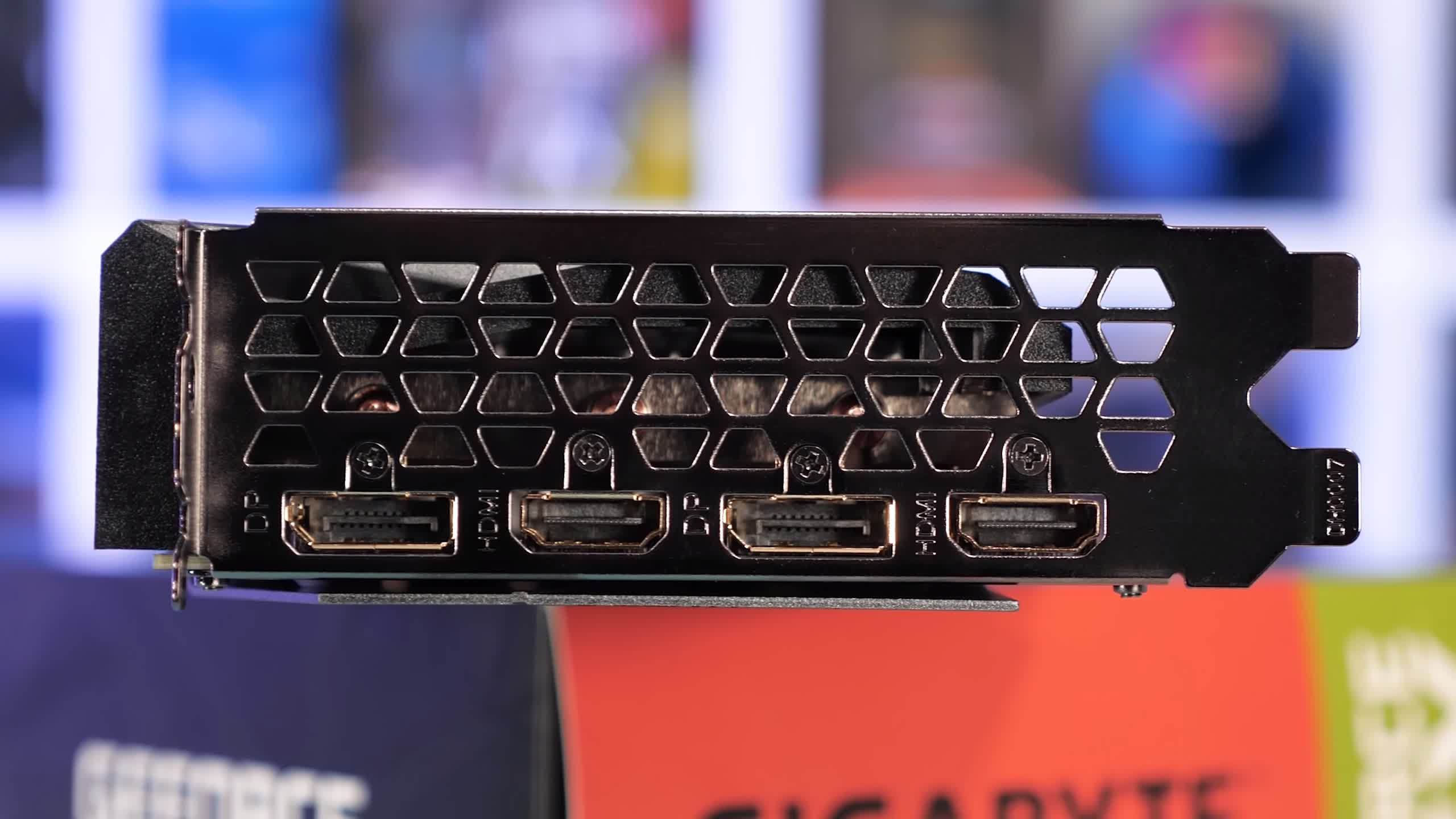The GeForce RTX 3060 is Nvidia's latest $330 desktop GPU offering that you're unlikely to find at its suggested retail price. With many things going on concurrently: the ongoing global pandemic, trade war, and cryptocurrency mining boom, that's the situation we find ourselves in at the moment.
The first batch of reviews of the RTX 3060 went live about ten days ago, and while we had to delay ours, on the plus side this allowed us to take a more accurate look at pricing and post-launch availability. Of course, we have the usual array of benchmarks to go over and we'll jump into that in a moment.
The RTX 3060 is based on the new GA106 die which measures 300mm2 and packs 3584 cores, 112 TMUs and 48 ROPs. That's 26% fewer cores and TMUs than the 3060 Ti version, but 40% fewer ROPs due to the downgrade from a 256-bit wide memory bus to 192-bit. Helping to minimize that reduction is higher clocked 15 Gbps GDDR6 memory which provides a peak bandwidth of 360 GB/s, so just a 20% reduction from the 3060 Ti.
This change to the memory subsystem meant that Nvidia couldn't pair the RTX 3060 with 8GB of VRAM. The options were essentially 6GB or 12GB. The former would have been embarrassing at this price point and with AMD set to release their mid-range parts with 12GB, Nvidia had little choice.
It also helps them to market the RTX 3060 and justify the $330 asking price which sees it come in just 18% cheaper than the 3060 Ti despite the significant reduction to the core configuration. On paper, the RTX 3060 doesn't appear to be a great value product, assuming all models sold at the MSRP, but we'll of course conduct a full performance evaluation and then work out where it lands in terms of cost per frame.
For testing we're still using the Ryzen 9 3950X test system as we progress on updating everything to be tested under the R9 5950X. Expect all that data once we get through this latest round of product releases. The test system is configured with 32GB of dual-rank, dual-channel DDR4-3200 CL14 memory.
We're going to look at the 1080p and 1440p data for half a dozen of the 14 games tested before we jump into our usual performance breakdown graphs.
Benchmarks
Starting with Watch Dogs Legion at 1080p, we see that the RTX 3060 is good for just 61 fps on average, making it slightly slower than the previous generation Radeon 5700 XT. A disappointing result to see in an Nvidia sponsored title. We're basically looking at RTX 2070-like performance, so $500 GPU performance from 3 years ago.
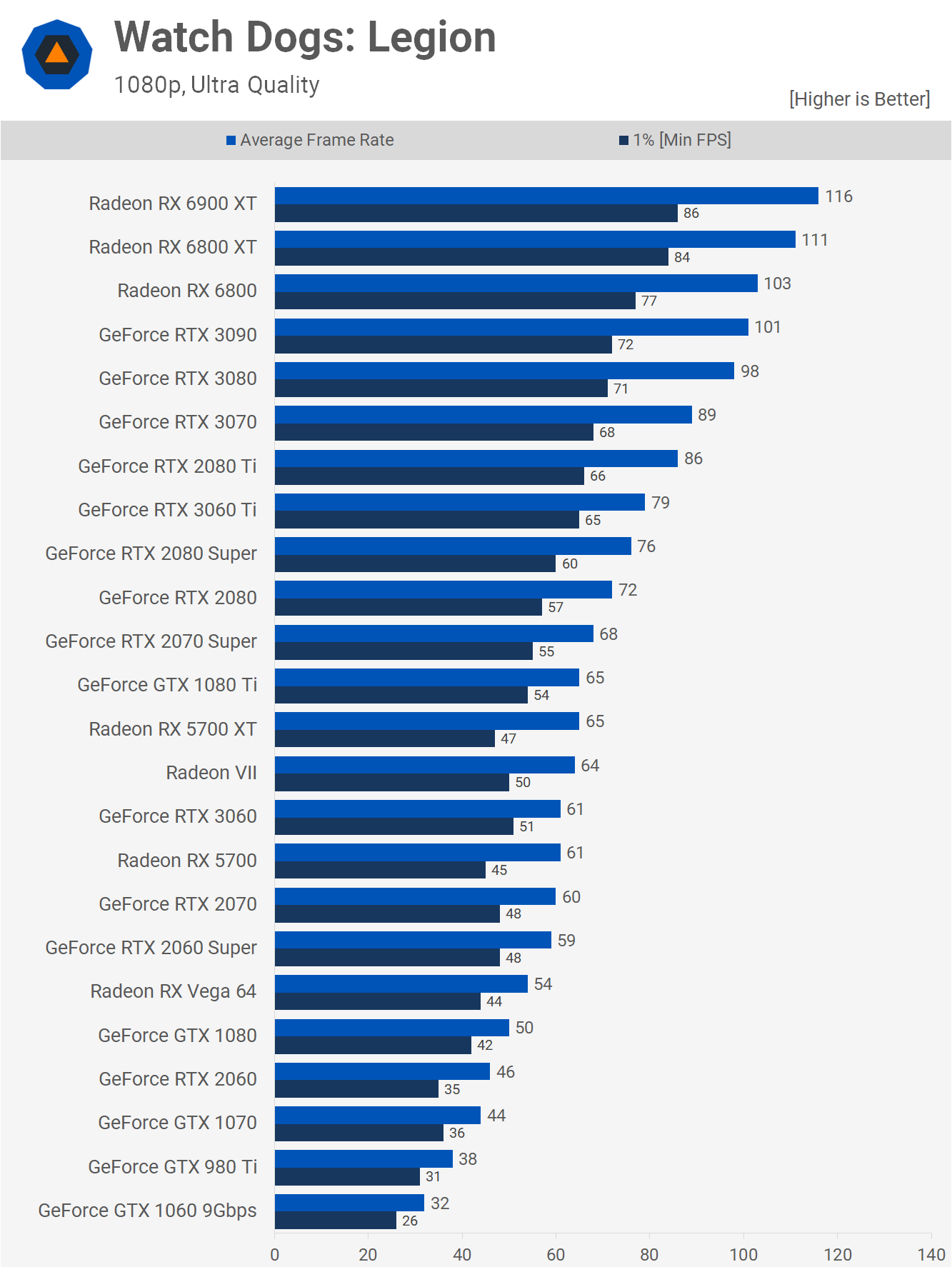
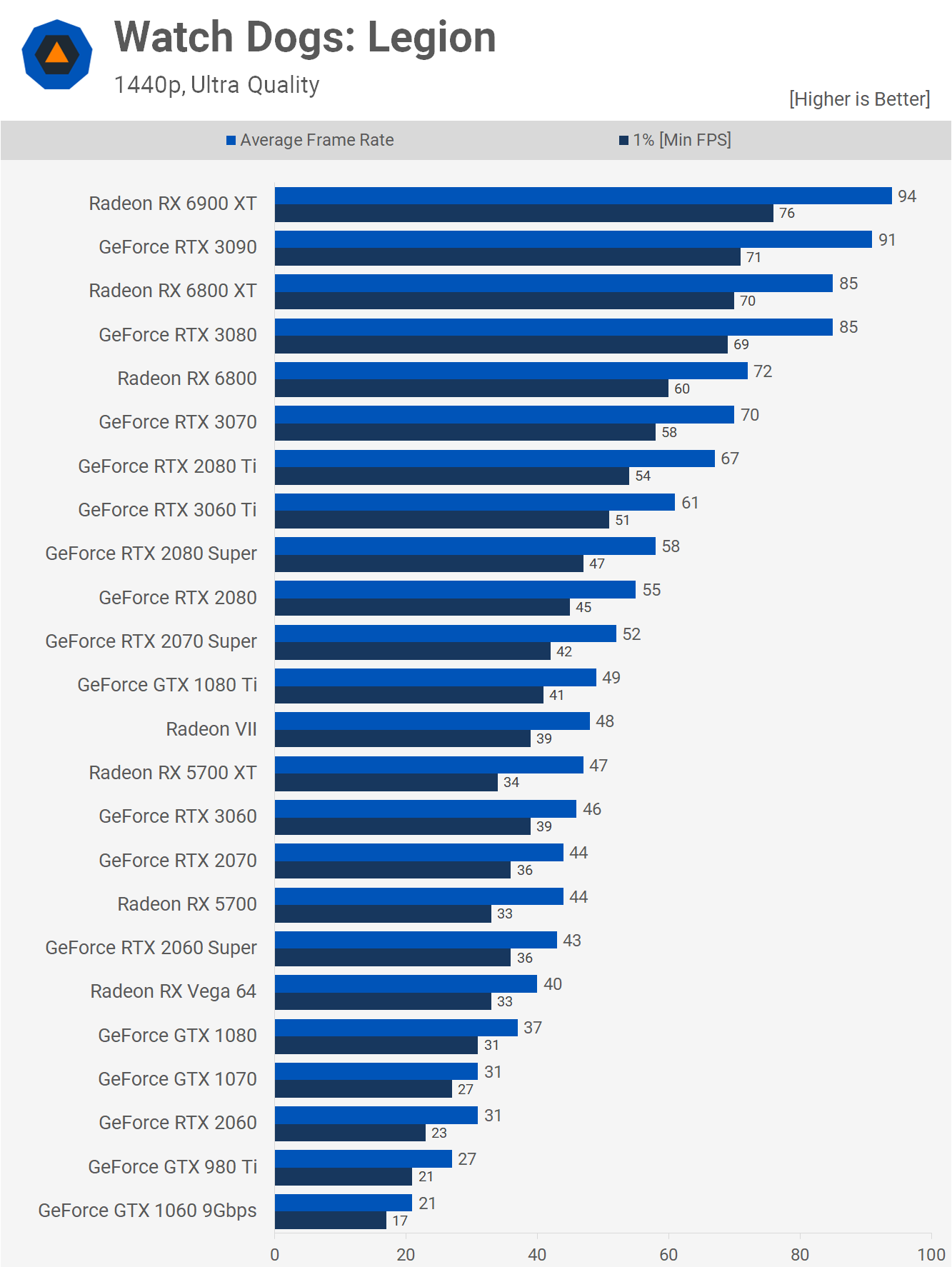
The margins are fairly similar at 1440p, at least relative to other GeForce GPUs such as the RTX 2070. The RTX 3060 manages to match the 5700 XT here, so that's certainly an improvement over what we saw at 1080p, but it's still 21% slower than the 3060 Ti.
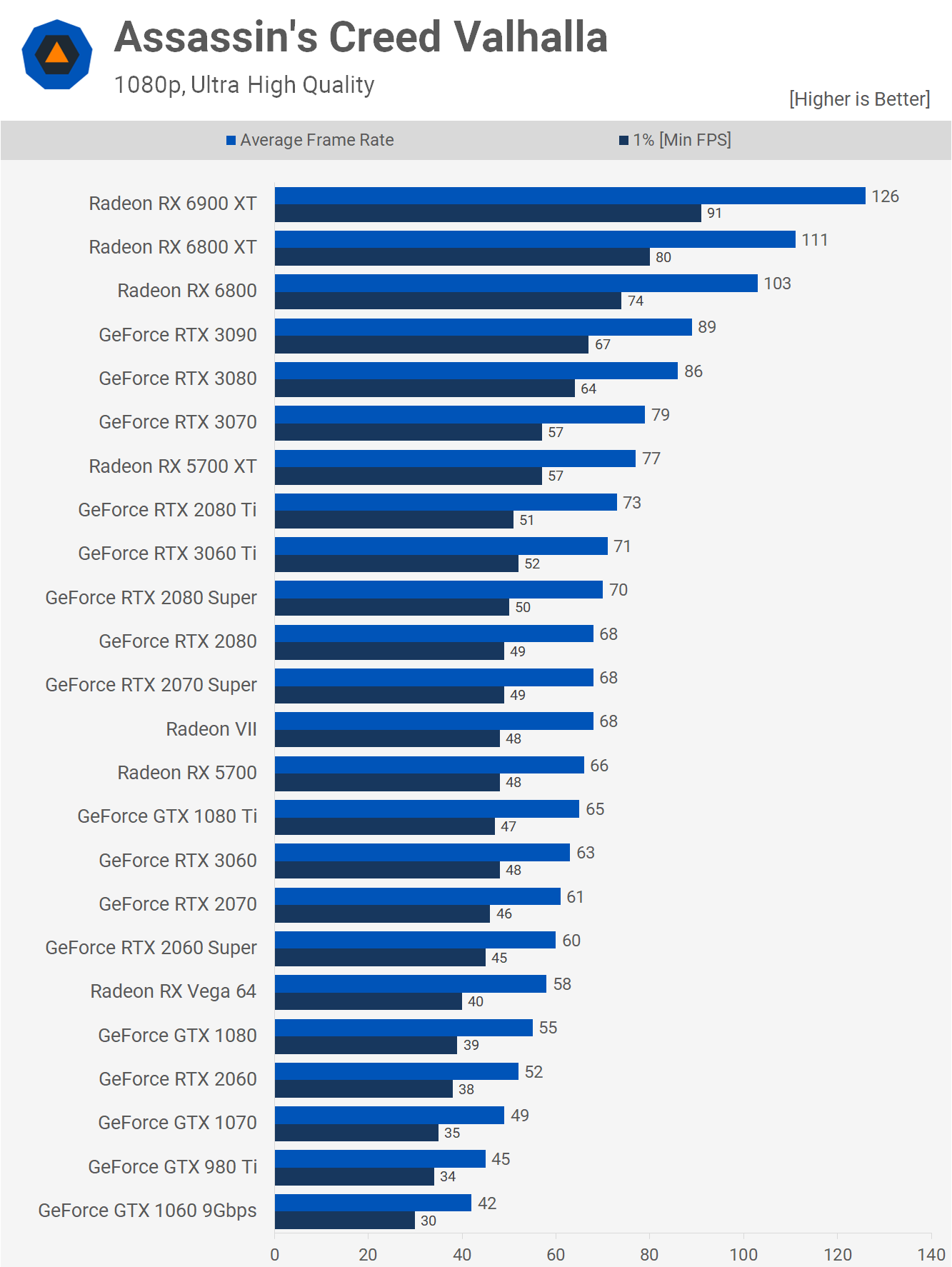
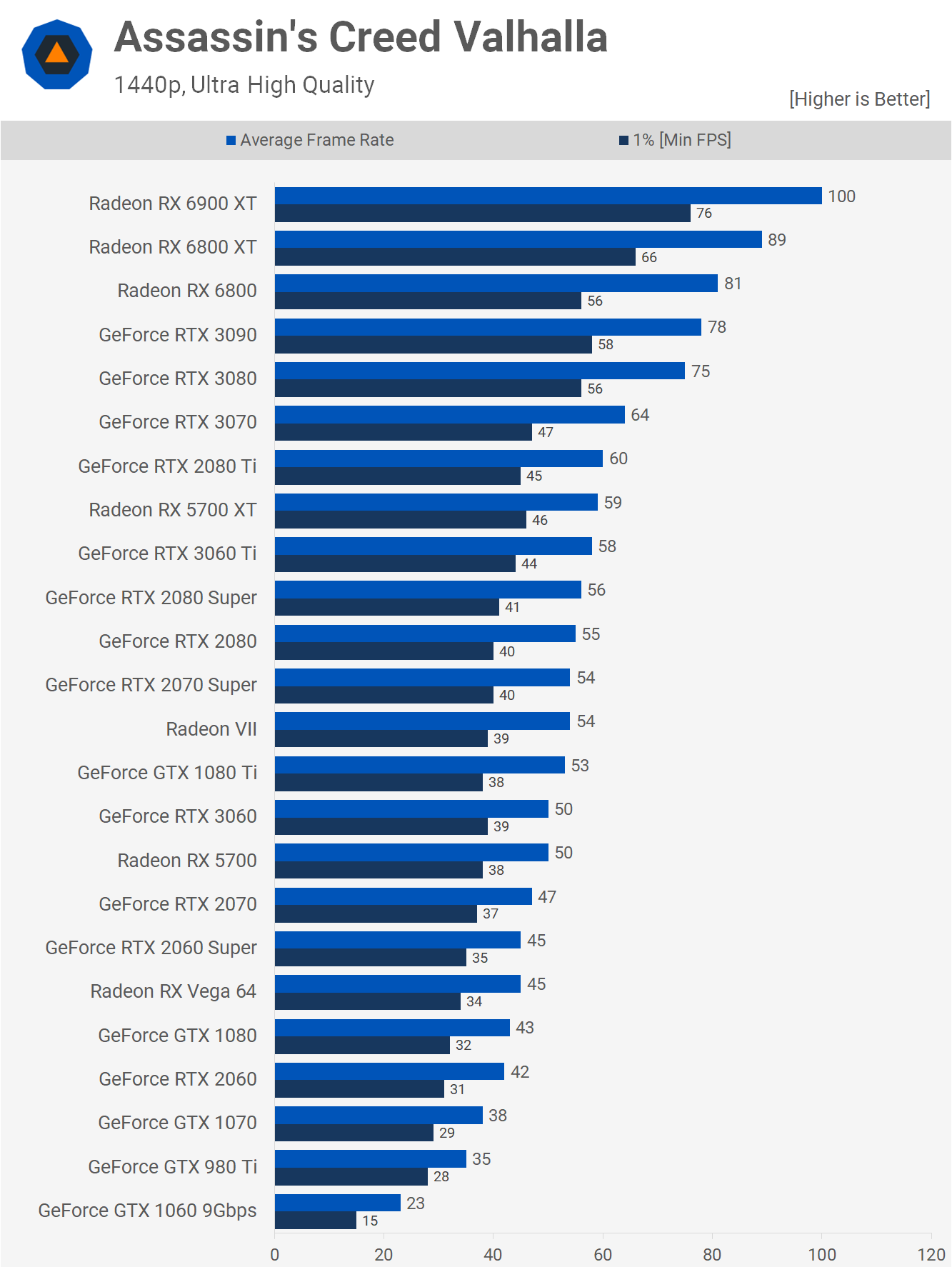
Assassin's Creed Valhalla is an AMD sponsored title and here the 5700 XT is well ahead of the RTX 3060 delivering 22% more frames. Again, the 3060 is comparable to the RTX 2070 and 8% slower than the 2070 Super. Relative to the 3060 Ti it does well a 13% deficit here, though we are only at 1080p.
The margin remains much the same at 1440p, where the 3060 was 14% slower than the 3060 Ti and 15% slower than the 5700 XT. It does match the vanilla RX 5700 and that means it's just a few frames faster than the RTX 2070.
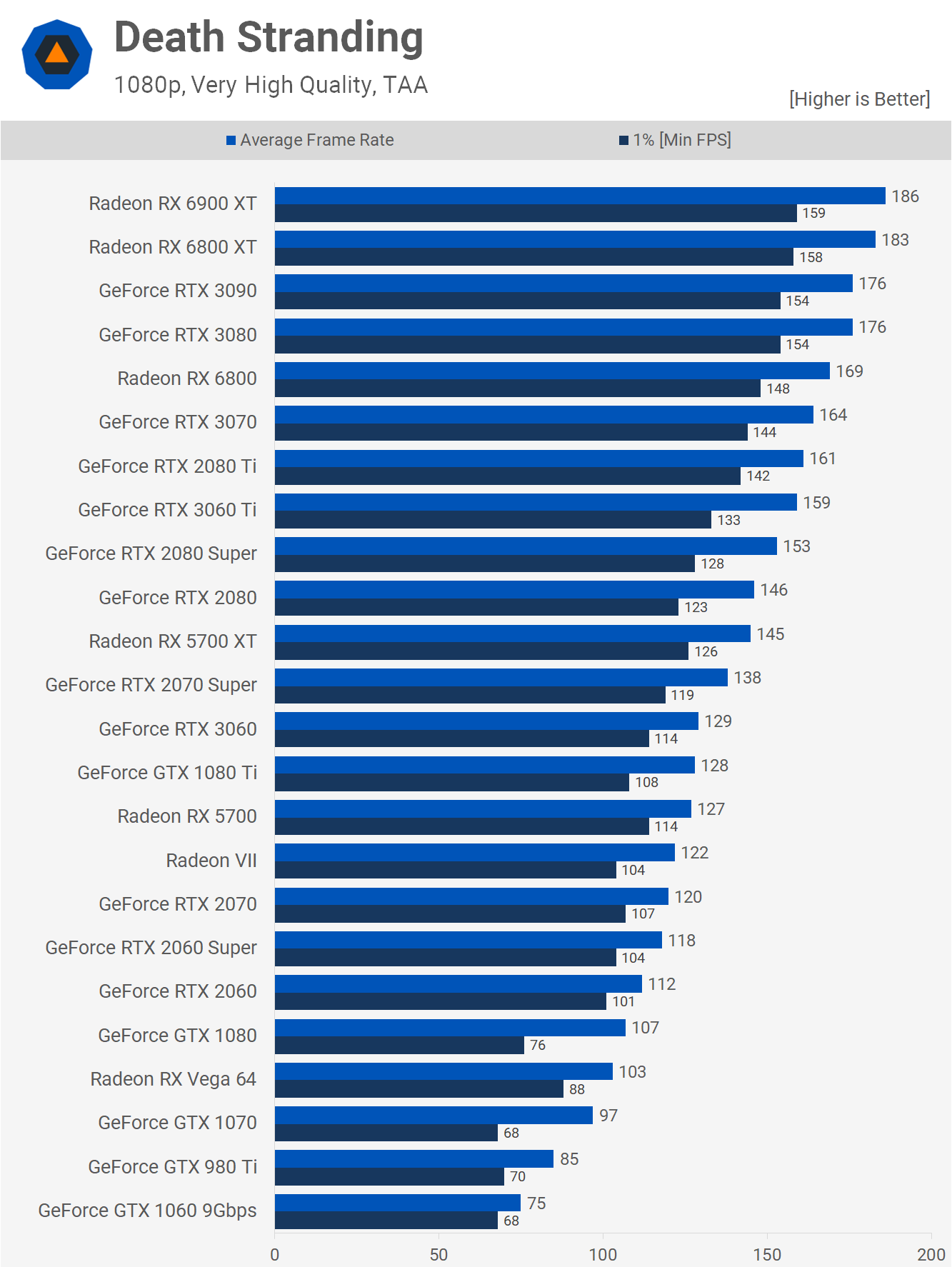
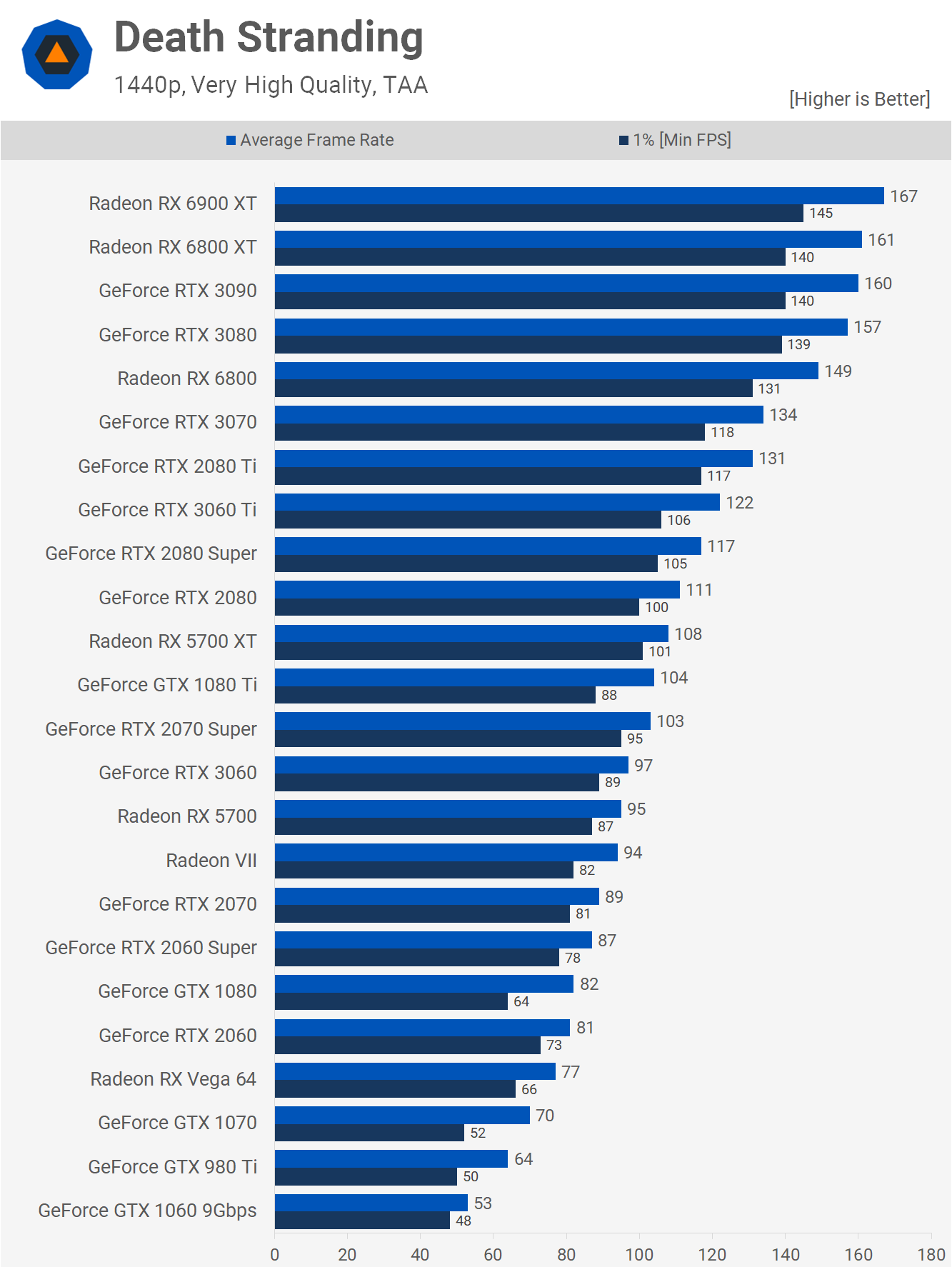
The RTX 3060 like most modern GPUs performs well in Death Stranding at 1080p, hitting 129 fps on average to match the GTX 1080 Ti and RX 5700. That said it's 11% slower than the 5700 XT and 19% slower than the 3060 Ti.
The 1440p data is mostly more of the same: 10% slower than the 5700 XT and now 20% slower than the 3060 Ti. It matches the RX 5700 again, so it was 9% faster than the RTX 2070.
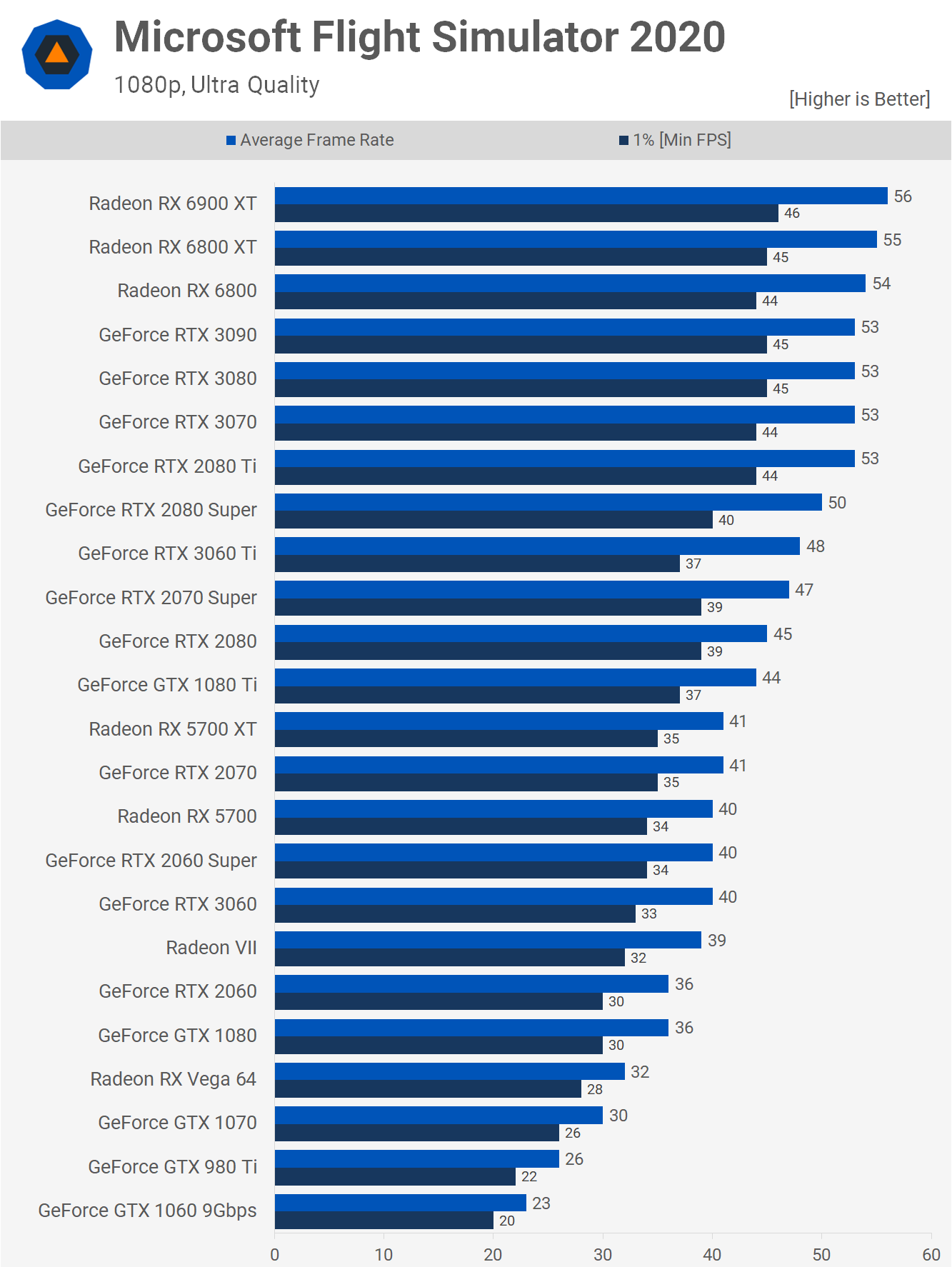
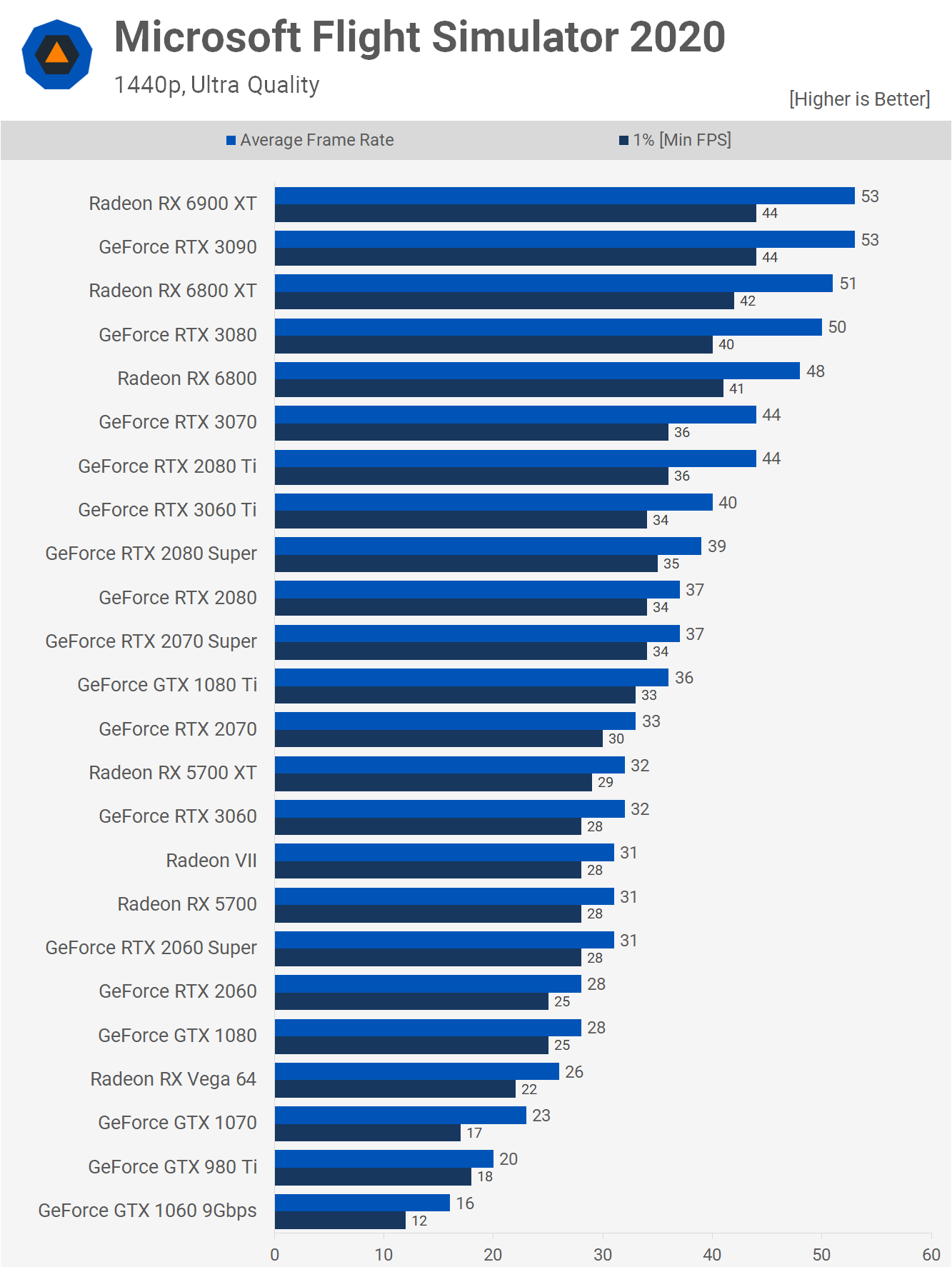
You can play Microsoft Flight Simulator 2020 at 1080p maxed out with the RTX 3060, though you are only looking at performance that's equivalent to the RTX 2060 Super, RTX 2070 or RX 5700 with 40 fps on average.
Then at 1440p it roughly matches the 5700 XT and RTX 2070 with 32 fps on average. This is just playable in our opinion – certainly not good enough for a shooter-style game, but for this simulator it works.

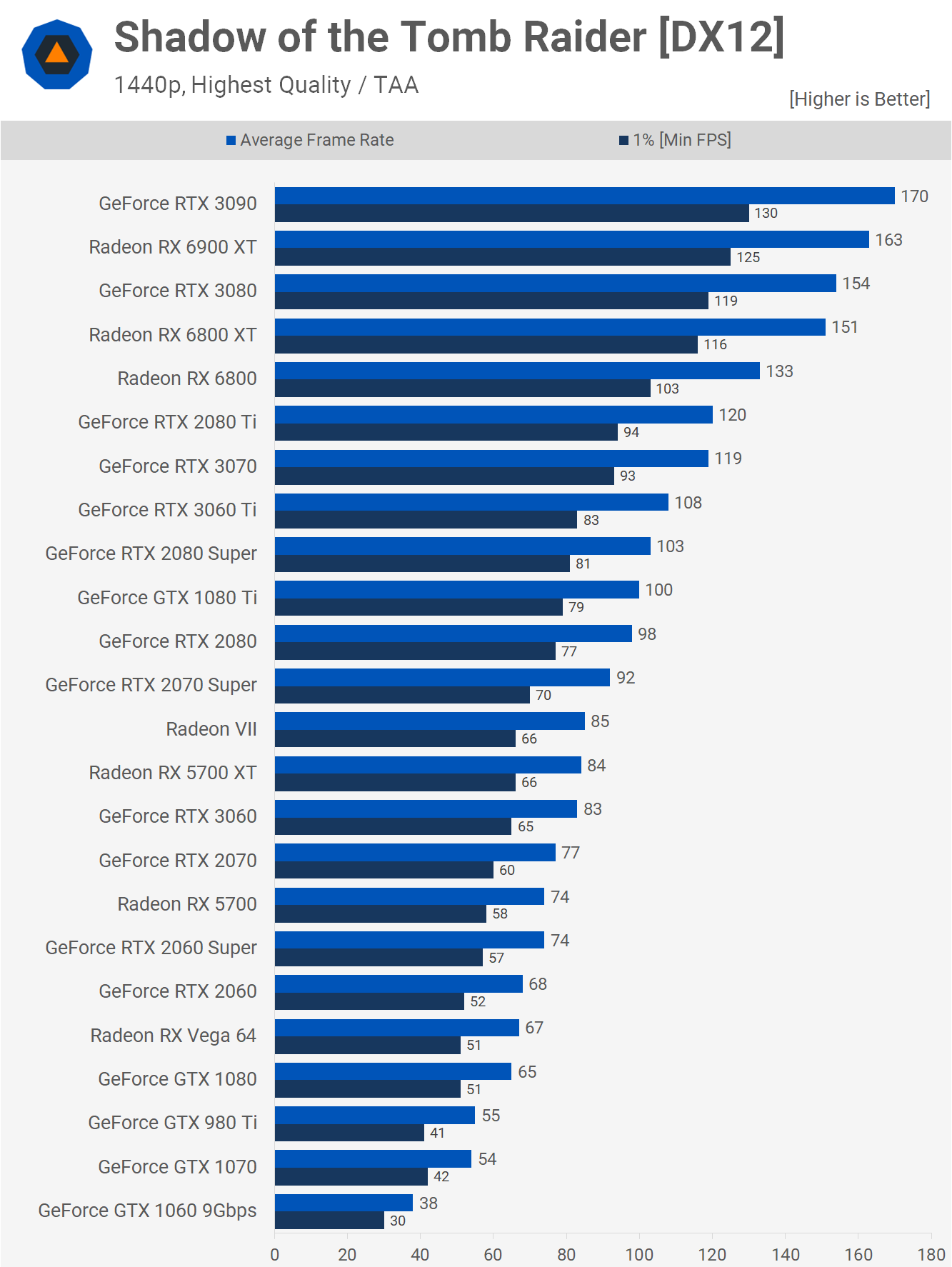
Moving on we have Shadow of the Tomb Raider. Here the RTX 3060 rendered 123 fps on average at 1080p which sees it match the 5700 XT to come in 21% slower than the 3060 Ti. When compared to the previous generation base model RTX 2060 which came in at a similar price, the 3060 is 18% faster.
At 1440p we drop to what's still a highly playable 83 fps. Again, the RTX 3060 is seen matching the 5700 XT, making it 23% slower than the 3060 Ti.
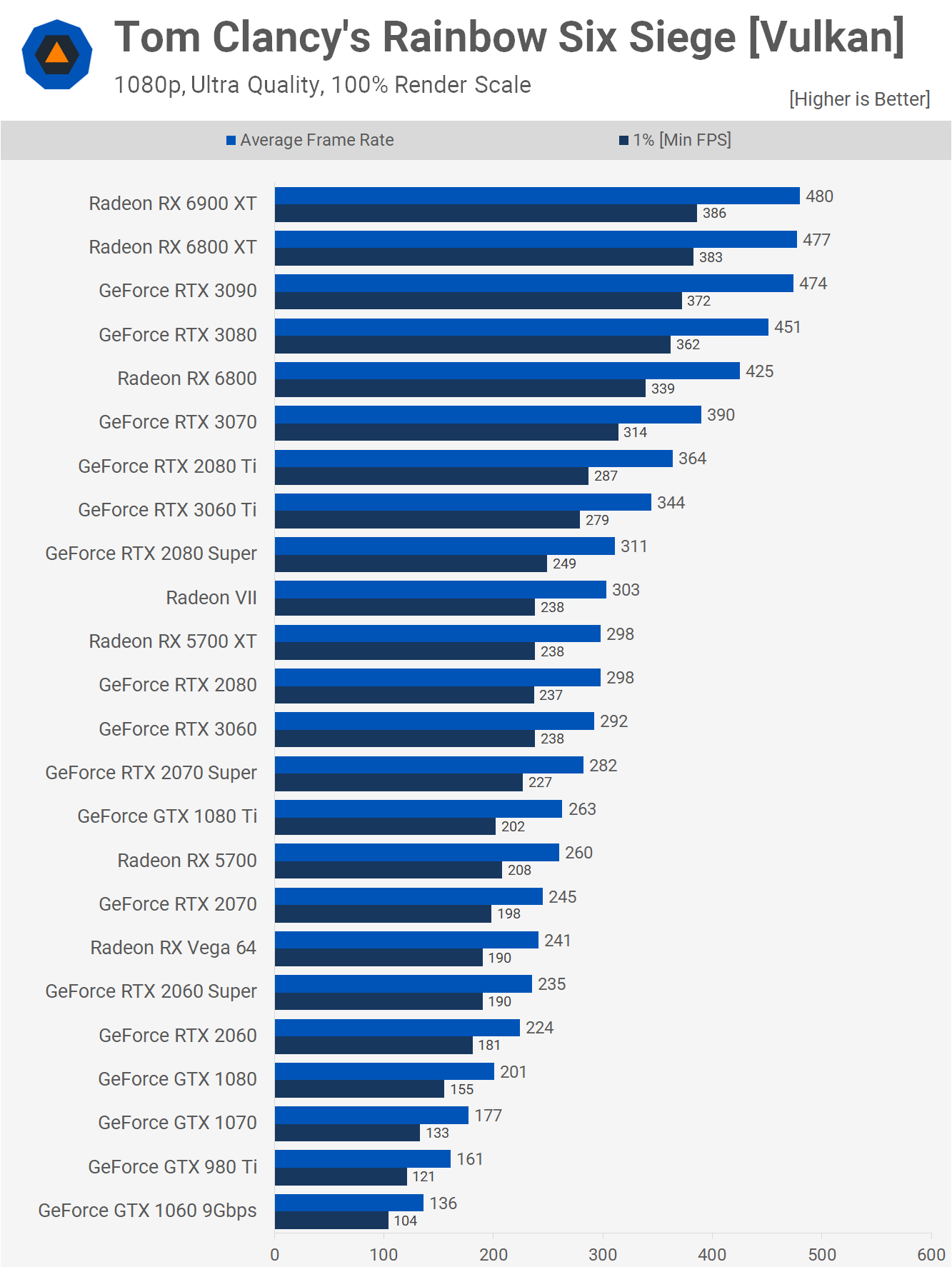
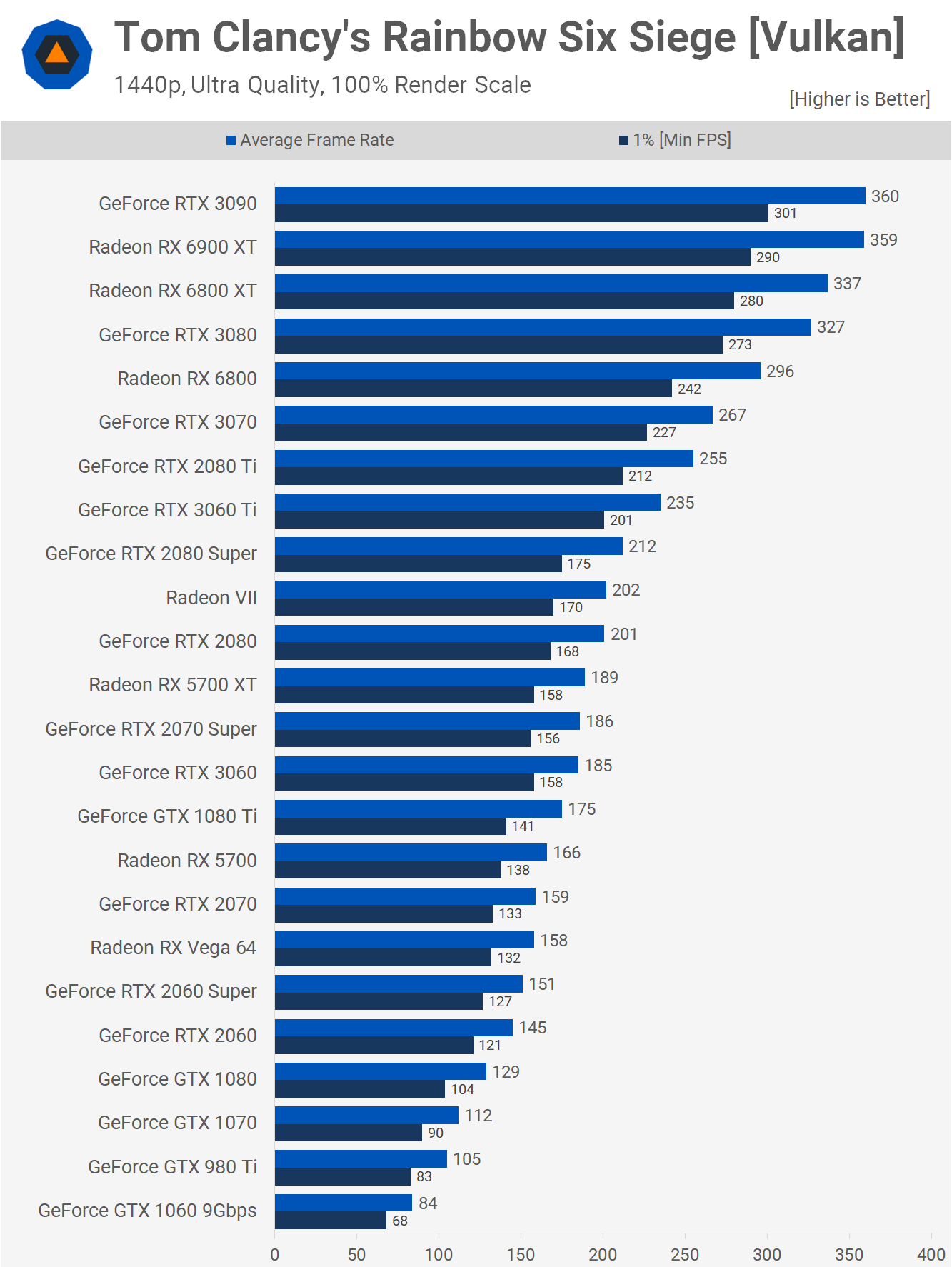
In Rainbow Six Siege at 1080p, the RTX 3060 is good for 292 fps, which makes it a little faster than the 2070 Super and places it roughly on par with the RTX 2080 and 5700 XT. It's some 12% faster than the similarly priced RX 5700, though that's not exactly progress.
We find that the 1440p data is similar with the RTX 3060 on par with the 2070 Super and 5700 XT, making it marginally faster than a vanilla 5700, but 21% slower than the 3060 Ti.
Performance Summary
Here's a look at the 14 game average data running at 1080p. The RTX 3060 is just 6% faster than the RX 5700, which is not great considering the MSRP is ~6% lower. When compared to the two-year-old AMD GPU, you're getting on average 6% more performance for what should be a 6% price saving, amazing stuff.
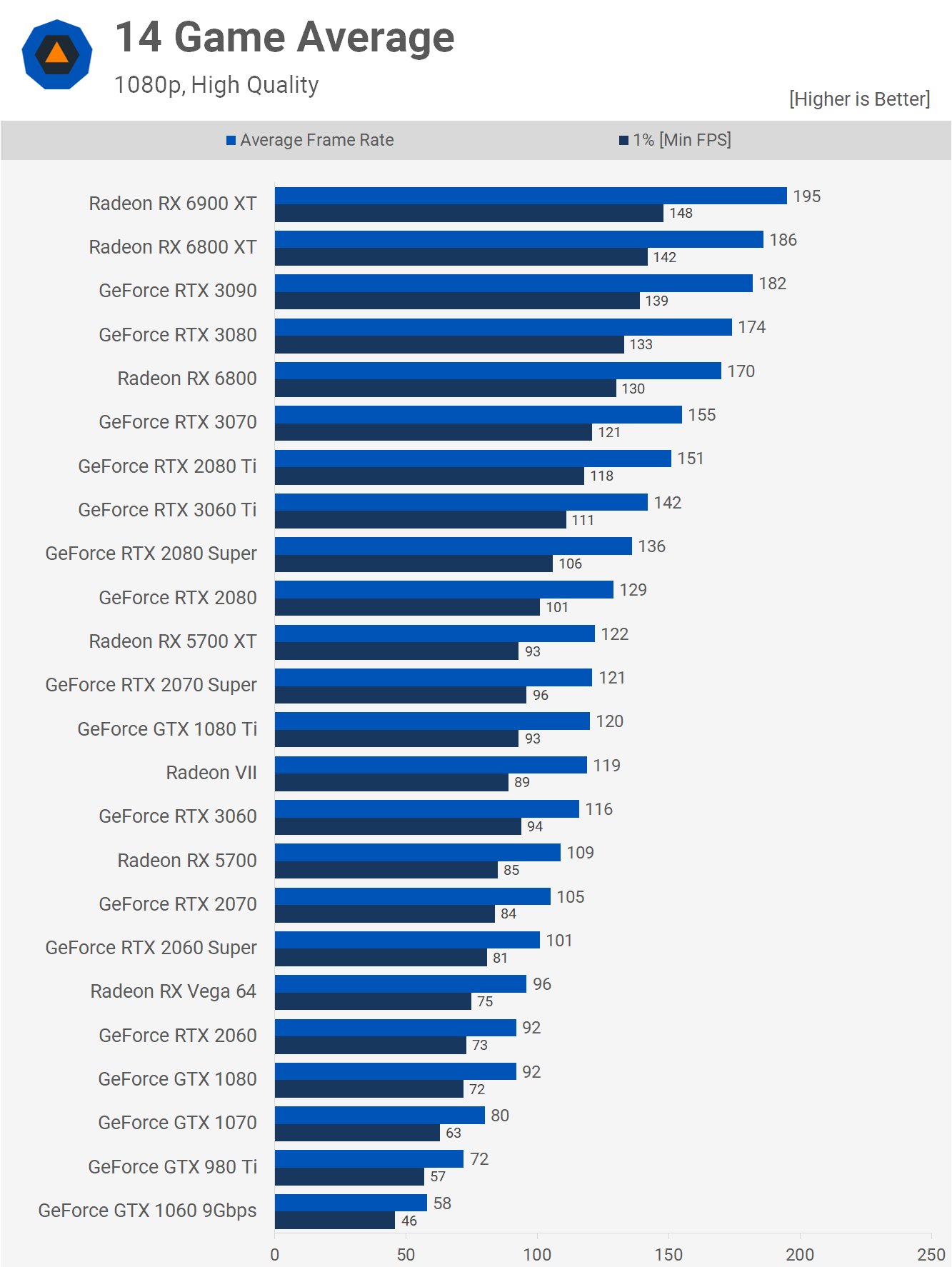
Compared to Nvidia's previous offerings, the RTX 3060 looks a bit more impressive, offering 15% more performance than the two-year-old RTX 2060 Super which cost 18% less. Of course, Turing was never great value, but looking exclusively at Nvidia products, the 3060 is quite good.

The 1440p data tells a similar story, where the RTX 3060 is on average 8% faster than the RX 5700 and 5% slower than the 5700 XT. It's also 17% faster than the RTX 2060 Super and 22% slower than the 3060 Ti.
Cost per Frame
Now let's take a look at the controversial MSRP-based cost per frame data. There are RTX 3060 cards listed for $330 at several retailers including Newegg, but whether or not they'll ever have stock for those models is hard to say. They certainly don't right now and that's hardly surprising. When compared to AMD, the situation does look better, the RX 6800 for example has an MSRP of $580, yet the cheapest model over on Newegg is $680 with most priced well over $700 and all out of stock.
It's possible that MSRP pricing for out of stock GeForce cards is a ploy to claim the MSRP at launch, with card makers advertising base model cards that won't get stocked anytime soon. We can't say if that theory is correct though, given we've heard from people who managed to snap up RTX 3070 and RTX 3080 models at the MSRP at some point. Whatever the case may be, supply of those models is even more limited and clearly for the vast majority of shoppers the MSRP means nothing.
Those reading weeks or months into the future, when GPUs are back to regular pricing, here's how the RTX 3060 stacks up at the claimed MSRP...
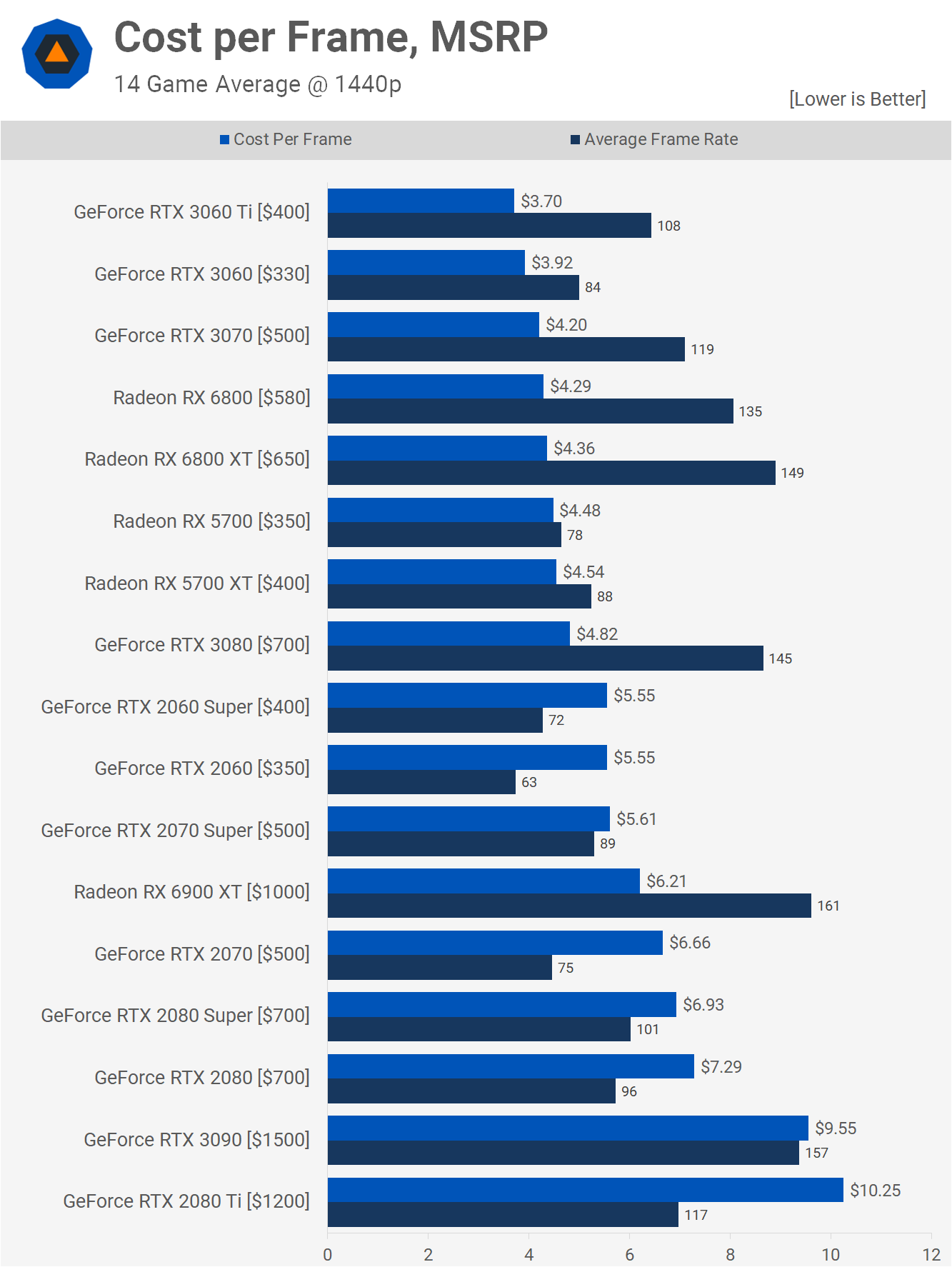
For $330, the GeForce RTX 3060 is slightly worse than the 3060 Ti in terms of cost per frame, coming in at a 6% premium. Given the RTX 3060 Ti is 12% better value than the RTX 3070, you'd expect the 3060 to cost no more than $280, so $50 less than the actual MSRP. Compared to previous-gen GPUs such as the Radeon 5700 XT, the RTX 3060 is just a 14% improvement in cost per frame.
As of writing, major tech retailers didn't have a single RTX 3080, 3070, 3060 Ti or 3060 in stock. Even the bundles where you have to buy a motherboard and memory were out of stock. That means if you want to buy a graphics card now, your best bet is to pay scalper prices over on eBay, something we strongly recommend you resist doing.
In the following graph we're looking at the average sale price of completed listings for new products over the past week on eBay. We've manually gathered this data and any dodgy listings, like a $500 RTX 3090, for example, were ignored.
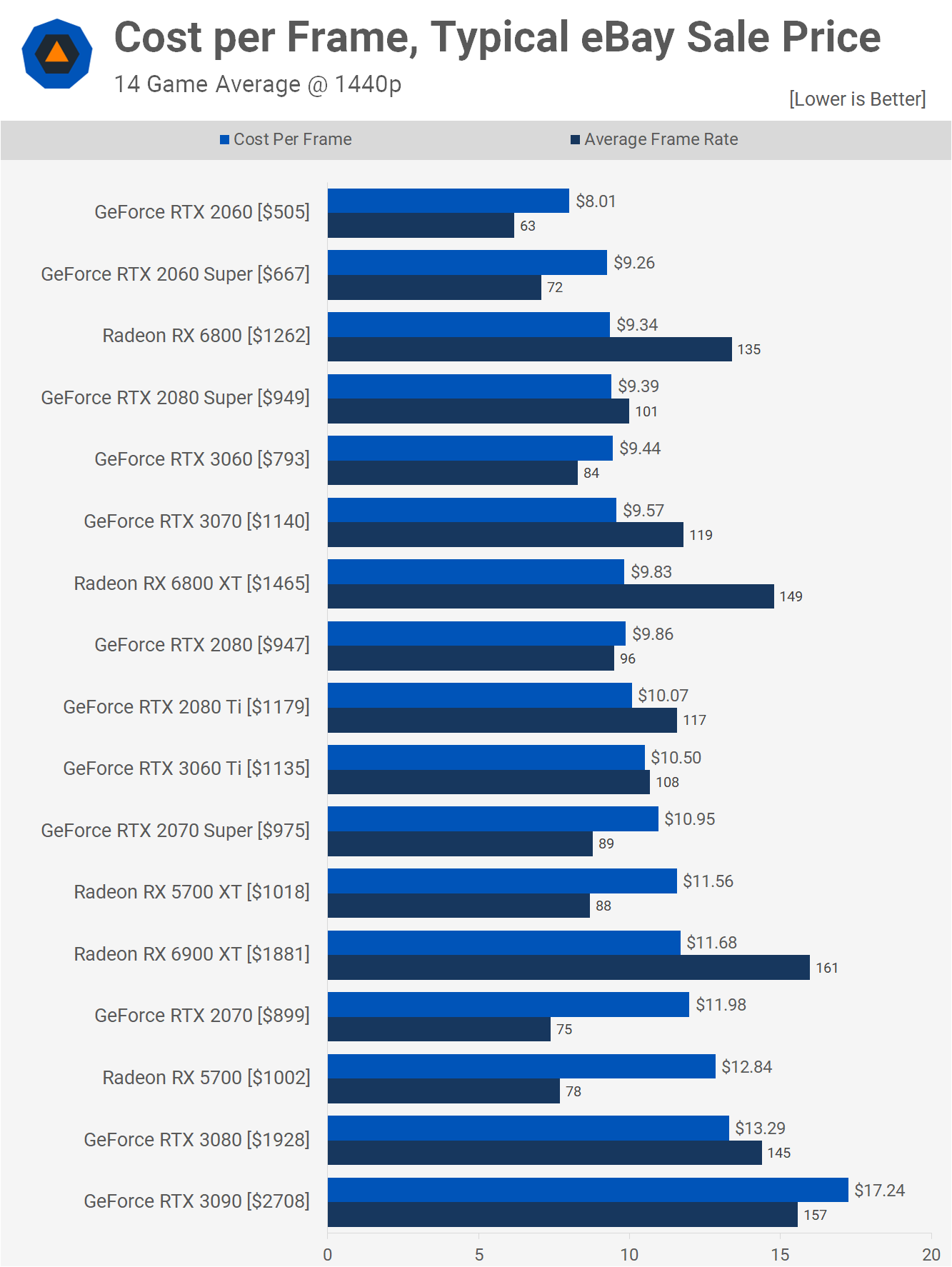
Of this bunch, the cheapest model was the GeForce RTX 2060 for $505 on average, roughly a 45% increase over the MSRP, resulting in a cost per frame of $8.01 when it should be $5.55.
The RTX 3060 comes in at $9.44 per frame, and while that does make it the cheapest of the GeForce 30 series, it was only a percent cheaper than the RTX 3070.
Admittedly though, this data is meaningless when you consider the average sale price of the RTX 3060 was $793, a staggering 140% markup over the MSRP. Certainly no one should pay that for an RTX 3060, but that's the bleak and realistic outlook for cards that are more readily available.
Ray Tracing and DLSS Performance
Before wrapping up, we wanted to take a quick look at ray tracing and DLSS performance along with power consumption and overclocking. For ray tracing testing, do note we're using the second highest quality preset for the three games, so not the minimum in-game quality settings. We're also testing at 1440p only (and not 1080p) as that makes better sense when you're prioritizing visual quality over high frame rates.

In Watch Dogs Legion at 1440p, the RTX 3060 was good for just 62 fps on average at the native resolution. Enabling quality DLSS boosted the frame rate by 30% to 81 fps, a very nice performance upgrade.
With medium quality ray tracing enabled with DLSS, the frame rate dropped below 60 fps to 54 fps on average. Not amazing, but certainly still playable. Then with ultra-quality ray tracing the frame rate dropped to 49 fps, not great but the game is still playable depending on your requirements. Without the aid of DLSS the game was unplayable using ray tracing on the RTX 3060 at 1440p as frame rates dropped well below 40 fps.
When compared to the RTX 2060, the 3060 was 13% faster when comparing native performance or DLSS-enabled performance. However, with ray tracing enabled the RTX 3060 was much more efficient, delivering up to 26% better performance.
This also shows just how poorly AMD's RDNA2 GPUs perform with ray tracing enabled, at least in these Nvidia optimized titles. Here the RX 6800 was 65% faster than the RTX 3060 without ray tracing, but with it enabled the Radeon GPU was just 31% faster and 16% faster with the ultra quality RT setting.
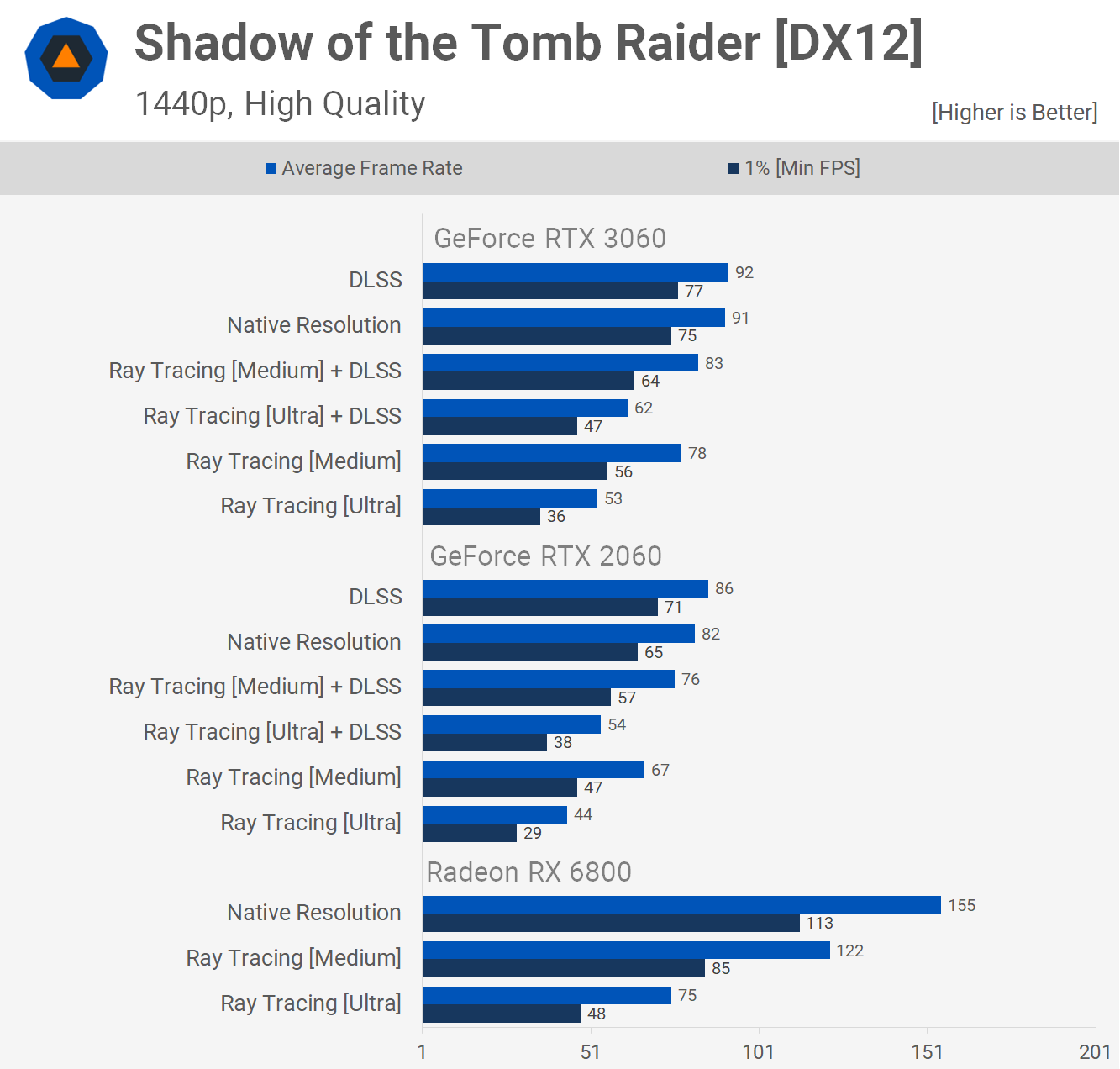
Shadow of the Tomb Raider only uses ray tracing for shadows and DLSS doesn't work nearly as well in this title, offering almost no performance uplift without ray tracing enabled. This time the RTX 3060 was 16-20% faster than the 2060 with ray tracing, while it was 11% faster for straight rasterization performance.

The performance uplift offered by DLSS in Control is massive. The RTX 3060 was 61% faster with DLSS enabled, so medium quality ray tracing with DLSS enabled was able to match native resolution performance, though do keep in mind we're only testing the game using the medium quality preset.
The GeForce RTX 3060 was 25% faster than the RTX 2060 for rasterization performance and we saw similar margins with ray tracing and DLSS enabled.
Power Consumption

The RTX 3060 isn't particularly impressive in the power consumption front, using only slightly less power than the RTX 3060 Ti, or at least that was the case for the Gigabyte RTX 3060 Eagle model we used for testing. When compared to the RTX 3060 Ti, we're looking at a mere 2% reduction in total system power usage.
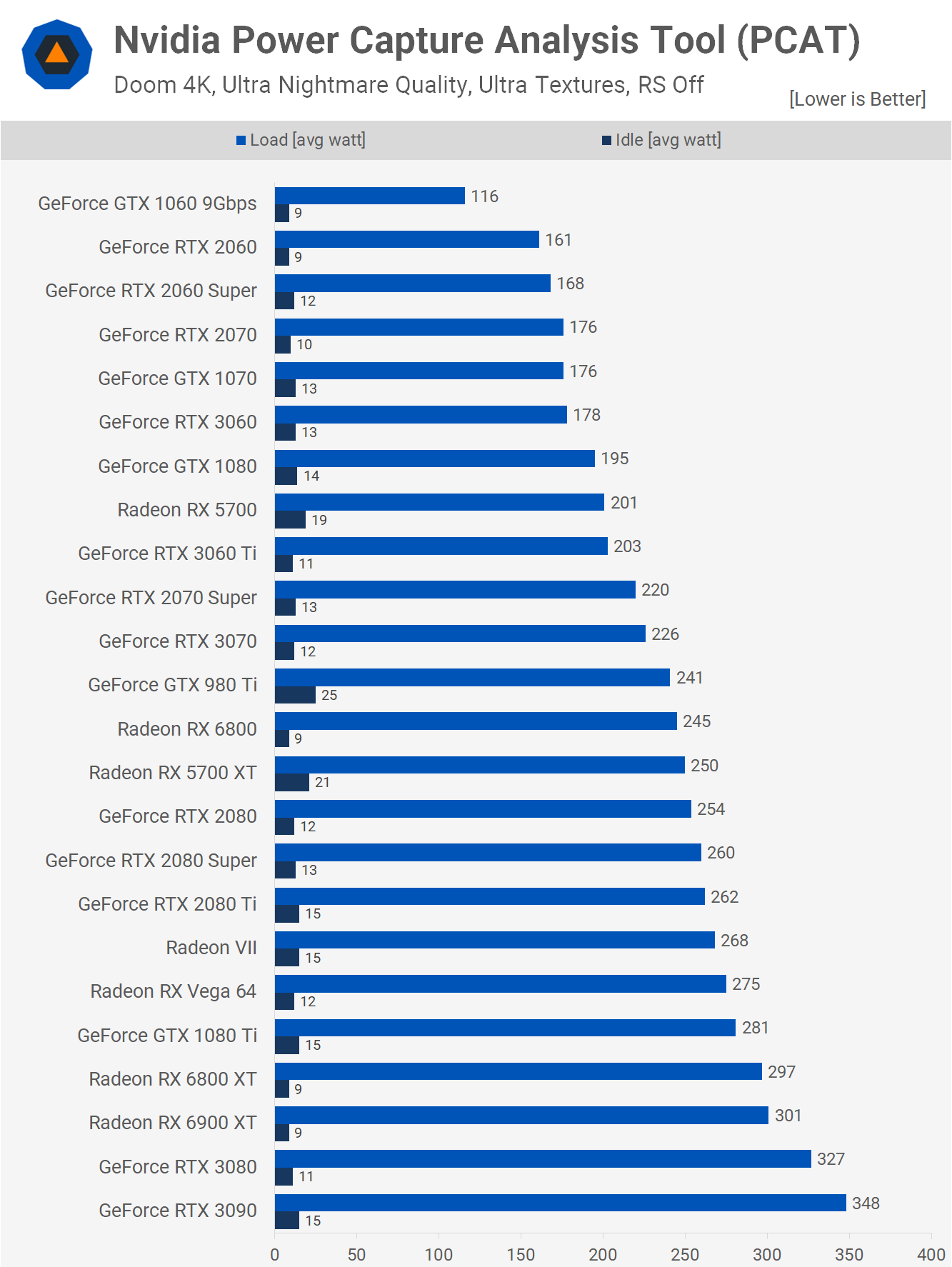
Here's a better look at graphics card power consumption using PCAT. We find that the RTX 3060 does consume 12% less power than the 3060 Ti, but given it was on average 22% slower, that's not a good result for power efficiency. It's a little more efficient than the 2060 Super, for example, consuming 6% more power for 17% more performance on average, not amazing but it's an improvement.

A very brief look at overclocking has the Gigabyte Eagle RTX 3060 overclocked from the stock boost frequency of 1777 MHz up to 1997 MHz, which resulted in a sustained in-game clock speed of 2.1 GHz. The memory also overclocked from the stock 15 Gbps transfer speed to 17.2 Gbps.
This manual overclock improved performance in Shadow of the Tomb Raider by 10%, taking the average frame rate from 83 fps up to 91 fps to match the RTX 2070 Super in this title. That's a pretty typical Ampere overclock.
What We Learned
Under normal conditions, as in you could buy graphics cards around the MSRP, the GeForce RTX 3060 would be a bit of a flop. It brings nothing new to the table, it's technically worse value than the RTX 3060 Ti, and while it does pack more VRAM, at this price point 8GB is enough, at least for now.
Put the VRAM factor aside and you can see the RTX 3060 has very little going for it. For RTX 2060 owners it's a very small upgrade, and it's almost a side grade for 2060 Super owners, while it's a downgrade for anyone with a 5700 XT.
If you own a GPU from a prior generation, like the GTX 1060 or even at GTX 1070, then the RTX 3060 is a decent upgrade in terms of performance, but you'd be better off spending a little more on the Ti version or waiting to see what AMD does at this price point.
Which of course, brings us to the present situation. At the moment, Nvidia has no incentive to make the RTX 3060 a killer value. Nvidia can still present this price point and sell as many cards as they can produce, evidenced by the fact that it sold out instantly. Even if the market returned to normalcy later in 2021 – something we're not expecting – Nvidia could simply refresh the 3060 series with a Super variant and adjust pricing to whatever is appropriate then.
Bottom line, the GeForce RTX 3060 isn't a bad product, it's technically very good, but pricing is simply not attractive to make it a compelling upgrade – but wait – all of that won't matter right now as gamers and miners fight over any GPU stock available. Until things improve, we don't expect Nvidia or AMD to release any good value GPUs while demand remains exceedingly high.
